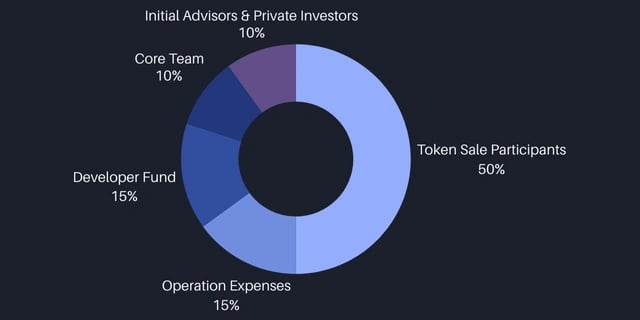订阅 wiki
Share wiki
Bookmark
0x Protocol
0x Protocol
0x协议是一个去中心化的协议,它支持在以太坊区块链上进行资产的点对点交换。0x由Will Warren和Amir Bandeali于2017年创立。[2][26][28]
概述
0x 是一个建立在 以太坊 上的无需许可的流动性协议,用于创建 去中心化交易所,连接 流动性提供者,并激励做市商推动 DeFi 资产交易。该协议支持 ERC-20、ERC-721 和其他 以太坊 代币标准的代币交换[1][3][4]。
0x 协议本质上是一种标准消息格式和 智能合约 套件,交易实体可以基于此交换数字资产或代币。消息格式是一组数据字段,包含关键信息,如要交易的数字资产或代币、交易的价格值、到期时间和交易方的身份。智能合约负责处理必要的业务逻辑,负责生成、发送、接收和处理与交易活动相关的数据。该系统还使用中继器,充当订单聚合器,负责将指定市场参与者的订单广播到市场或交易所[7][8][9]。
0x 团队于 2021 年 1 月宣布推出该协议的 v4 更新。0x v4 投票流程已于 1 月 16 日至 1 月 23 日进行,旨在将报价 gas 成本降低 70%。根据 0x Labs 博客,此版本支持可定制的模块来执行原子操作,包括代币包装和解包。
产品
0x API
0x API 是一系列可以一起或单独运行的服务和端点集合。总体而言,这些 API 提供了 0x 流动性、0x 质押 数据等的接口。0x API 是一种从 0x Mesh 以及链上来源(如 Kyber Network (KNC)、Uniswap、Oasis Network (ROSE)、Curve Finance 和其他 去中心化交易所 (DEX) 网络)获取流动性的方法。0x API 自动创建一个订单,该订单可以直接传递给用户的 智能合约 以在链上结算,并且不需要 API 密钥。
0x Mesh
0x Mesh 是一个用于共享订单的点对点网络。0x Mesh 针对不同类别的用户有几种不同的用例:
- 中继者可以使用 Mesh 相互共享订单,并接收来自做市商的订单。这使他们能够增加订单簿的深度并提供更好的用户体验。
- 做市商可以使用 Mesh 来扩大受众范围。他们的订单可以发送到整个网络,被许多交易场所接收,因此更有可能被执行。
- Mesh 允许一种新型的中继器,称为“无服务器中继器”。在无服务器中继器模型中,每个用户都在浏览器中运行 Mesh,没有后端服务器或数据库。相反,对等方直接相互共享订单。
Matcha
Matcha 于 2020 年 6 月推出,是一个去中心化交易所 (DEX),用户可以通过以太坊 智能合约 基础设施进行 点对点 代币交换。与其他仅使用单一流动性来源的交易所不同,Matcha 聚合了来自多个来源的流动性,包括 0x、Uniswap、Balancer、Curve、Kyber Network、Oasis Network 等。通过使用智能订单路由,Matcha 自动为最终用户提供最佳交易价格。
Matcha 的独特之处在于其对教育的关注。大多数其他交易所只是简单地列出可用的代币和交易对,而不提供相关信息。Matcha 投入建设资产页面,作为用户发现和了解代币的场所。例如,在执行交易之前,Matcha 会向用户显示详细的订单审查、估计的滑点和价值损失,以及交易时间估计器,以避免因网络拥塞而造成的任何意外。
ZRX 代币
0x 协议由一个名为 ZRX 的 ERC-20 实用代币提供支持。托管链下订单簿并提供面向用户的应用程序的节点(也称为中继器)会收到 ZRX 代币的支付(作为交易费用)。这些应用程序会呈现此信息并允许用户进行、完成和取消交易。ZRX 还可以用于参与平台治理,帮助持有者建议和投票决定协议的变更。
0x 在 2017 年 8 月完成了代币销售,在不到 24 小时内以每个 ZRX 0.048 美元的基本价格筹集了 2400 万美元的以太币 (ETH)。总共铸造了 1,000,000,000 个 ZRX 代币,初始分配如下:
- 50% 给代币销售参与者;
- 15% 用于运营费用;
- 15% 作为开发者基金;
- 10% 给团队,分 4 年归属;
- 10% 给初始顾问和私人投资者。

2019 年,0x 宣布对 ZRX 代币进行改革,增加了额外功能,并允许 ZRX 持有者将其股份委托给做市商,以赚取被动奖励,同时保留其投票权。
0x 协议 v4 更新
0x 协议 v4 于 2021 年 2 月 16 日发布,引入了多项旨在改进去中心化交易的更新。这些更新旨在简化 0x 生态系统中做市商、交易者和中继者之间的互动,重点是提高效率和安全性。
中继器和费用协商
0x协议中的中继器维护链下订单簿,并在交易完成后收取交易费用。该过程涉及做市商创建包含费用的订单,这些费用根据中继器的计划设定。这些订单经过验证并发布在订单簿上,做市商可以通过以太坊区块链上的智能合约来完成这些订单。这种设置实现了去中心化和灵活的交易费用协商。
智能合约函数
该协议通过Ethereum 智能合约运行,提供订单填充和取消的基本功能。合约使用 `ecrecover` 函数来验证 maker 的签名,确保交易的完整性。订单可以被部分填充,引用存储在合约中以防止重复。
去中心化治理和持续更新
0x 协议 v4 还包括一个去中心化治理机制,该机制允许集成更新,而不会中断现有的 dApps 或最终用户。将发行协议代币,使市场参与者能够向中继者支付 交易费用 并参与治理,从而支持协议的安全更新。
代币注册表和ERC20标准
链上代币注册表将用于存储ERC-20代币的元数据,从而更容易验证合约地址和汇率。该协议与任何使用ERC-20接口的代币保持兼容,简化了与外部合约的集成。 [29][30]
新的 Matcha DEX 聚合器
0x 于 2023 年 5 月 17 日推出了最新版本的 DEX 聚合器 Matcha。此次更新引入了关键功能,旨在改善 去中心化金融 生态系统中的用户体验。
新的“Matcha Auto”交易模式旨在提高交易被纳入下一个区块的可能性,从而降低交易失败的风险。此外,Matcha 将其代币覆盖范围从 11,000 个增加到 470 万个,流动性提供商 的数量增加了 47%,从 70 个增加到 100 多个 DEX。
该平台的智能路由整合了来自多个 去中心化交易所 的价格,为用户确保了具有竞争力的价格。在过去的 30 天里,Matcha 记录了大约 16,900 名用户和 60,310 笔交易,总交易量接近 5.29 亿美元。
最新版本还引入了跨链交换功能,支持在七个 区块链(以太坊、Optimism、Polygon、Arbitrum、Avalanche、Base 和 BNB Chain)之间进行资产交换。[31][32][33]
Gasless API
Gasless API是由0x协议于2024年1月推出的功能,旨在通过消除用户直接管理gas费的需求,从而促进去中心化交易。此举扩展了自2020年以来一直在运营的现有0x Swap API的功能。Swap API已被500多个团队使用,以访问九个区块链上的100多个交易所,为700万用户促成了超过1390亿美元的交易量和6500万笔交易。
降低去中心化金融的复杂性
在去中心化金融(DeFi)领域,gas费用和相关复杂性,例如 gas 价格波动、交易延迟和代币余额不足,通常被视为用户采用和参与的重要障碍。根据 Coinbase Wallet 的一份报告,大量的 Ethereum 交换(69%)遇到“gas 不足”错误,这是一个常见的摩擦点。
Gasless API 通过允许无 gas 交换来解决这些挑战,其中 gas 费用由 API 承担并包含在总交易成本中。这种机制消除了用户维持专门用于 gas 费用的原生代币余额的需求。gas 费用被纳入交易中,费用以交易代币结算。
Gasless API 的特性
-
简化流程: Gasless API 消除了单独的 gas 费用管理和 token 批准的必要性,旨在简化用户交互。
-
优化交易速度: 该 API 根据实时条件动态调整 gas 费用,以提高交易在下一个区块中被处理的可能性。
-
增强交易可靠性: 通过在提交前模拟交易,Gasless API 可以帮助识别和防止潜在的问题交易。
-
访问流动性: 该 API 连接到来自 100 多个 自动做市商 (AMM) 和其他做市商的流动性,使用元交易来实现最佳交易价格。
-
开发者集成: Gasless API 可以通过最少的编码进行集成,并得到各种技术资源的支持,包括教程和文档。
兼容性和使用
Gasless API可在多个区块链网络上使用,包括以太坊、Optimism、Base、Arbitrum和Polygon。它可以与0x Swap API结合使用,以提供额外的交易选项,例如在gas不足时自动切换到无gas模式。
Robinhood、Coinbase和Matcha等组织已将Gasless API集成到其平台中。来自这些实体的报告表明,实施后交易成功率和用户参与度有所提高。 [36]
0x协议的定价引擎:v2
0x协议于2024年7月推出了其最新的进展,即0x v2,这是一个专门为链上应用设计的更新的定价引擎。这个新引擎专注于优化交易执行、访问广泛的流动性、增强安全功能和改进的货币化工具,以满足Web3生态系统中不断发展的业务需求。
这个版本与协议之前的版本不同。虽然四年前(2021年)推出的0x协议v4通过为开发者提供对聚合DEX流动性的访问,为去中心化金融(DeFi)应用奠定了基础,但0x v2代表了新一代的定价和交易技术。它专门用于处理日益增长的链上流动性复杂性,这种复杂性来自于不断增加的代币、去中心化交易所(DEX)和区块链网络。
特性和功能
高级路由机制: 0x v2 引擎采用了一种路由算法,称为 Argon 路由器,用于识别执行交易的有效路径。该算法采用两种主要技术:
-
多路复用: 此方法将交易分散到各种流动性来源,以最大限度地减少价格影响并提高执行效率。
-
多跳路由: 这种方法允许通过中间代币步骤执行交易,从而获得更深的流动性并最大限度地减少价格影响,特别是对于涉及流动性有限的代币的交易。
该路由机制还包括一个询价(RFQ)系统,该系统有助于访问做市商的流动性,类似于中心化交易所,从而增强了交易路径优化的选择,同时最大限度地减少滑点。
Gas 成本管理: 定价引擎集成了 gas 成本估算模型,该模型使报价与实际 gas 费用保持一致。此功能旨在减少因 gas 估算不准确导致的交易失败,并降低交易回滚率。
安全协议: 0x v2 采用多种安全协议,包括 Permit2 标准,以解决与代币授权相关的风险。该引擎的 智能合约,称为 0x Settler,使用一次性、基于金额的签名来限制授权风险,从而减少与无限期批准相关的潜在漏洞。
0x v2 智能合约 的安全评估已由 Ouroboros、Trail of Bits 和 OpenZeppelin 等独立公司进行。这些合约使用安全工具进行持续分析,以维持保护标准。
货币化工具: 0x v2 为企业提供了管理货币化流程的工具,例如控制用于收取费用的代币类型。此功能有助于维持可预测的资产负债表并降低财务管理的复杂性。
附加功能
-
流动性来源集成: 0x v2 能够集成新的流动性来源,以支持不断发展的交易环境。
-
手续费转移 (FoT) 代币处理: 该引擎支持交易具有嵌入式转移费用的代币,以适应各种代币类型。
-
错误处理改进: 增强的错误验证和清晰的错误消息旨在改进开发流程并减少故障排除时间。 [35]
0x v2 漏洞赏金计划
0x协议于2024年7月启动了一项漏洞赏金计划,与其更新版本0x v2合作,合作方为Immunefi。该计划向公众开放参与,对于识别出的关键漏洞,提供高达100万美元的奖励。该计划旨在识别和解决0x v2架构中的潜在漏洞,从而有助于提高其智能合约和相关系统的整体安全性。
0x v2漏洞赏金计划的范围包括0x Settler(智能合约)、Swap API、Gasless API和Matcha网站。奖励金额根据Immunefi漏洞严重程度分类系统V2.3确定,所有付款均以USDC在以太坊区块链上进行。
对于智能合约中的关键漏洞,奖励设置为直接受影响资金的10%,最高可达1,000,000美元。确切金额根据漏洞报告提交的时间和日期计算,最低奖励为100,000美元,以鼓励及时报告重大安全问题。高级别漏洞,例如涉及盗窃或永久冻结未声明的收益或版税的漏洞,可能会获得35,000美元至100,000美元的奖励,具体取决于风险级别。在网站或应用程序中发现的关键漏洞有资格获得50,000美元的奖励。 [34]
团队
- Will Warren — 联合创始人 & 联合首席执行官
- Amir Bandeali — 联合创始人 & 联合首席执行官
- Alex Xu — 幕僚长
- Ben Burns — 设计师
- Brandon Millman — 工程经理
- Jacob Evans — 高级工程师
- Greg Hysen — 工程经理,协议
- Blake Henderson — 产品经理
- Zack Skelly — 人才主管
- Remco Bloemen — 技术研究员
- Chris Kalani — Matcha总经理
- Peter Zeitz — 研究员
- Clay Robbins — 生态系统开发主管
- Eugene Aumson — 高级工程师
- Jason Somensatto — 高级法律顾问
- Steve Klebanoff — 高级工程师
- Xianny Ng — 工程师
- Brent Oshiro — 社区参与主管
- Daniel Pyrathon — 高级工程师
- Lawrence Forman — 高级协议工程师
- Paul Vienhage — 研究工程师
- Rui Zhang — 公司法律顾问
- Mason Liang — 研究工程师
- Patryk Adaś — 设计师
- Alex Kroeger — 数据科学家
- Theo Gonella — 产品经理
- Alex Towle — 协议工程师
- Oskar Paolini — DevOps工程师
- Michael Zhu — 协议工程师
- Fulvia Morales — 产品经理
- Kim Persson — 工程师
- John Johnson — 高级工程师
- Nicole Setter — 工作场所体验专员
- Max Torres — 财务主管
顾问
- Fred Ehrsam, Paradigm
- Olaf Carlson-Wee, Polychain Capital.
- Joey Krug, Pantera Capital, Augur.
- Linda Xie, Scalar Capital.
- David O. Sacks, Craft Ventures.
发现错误了吗?
